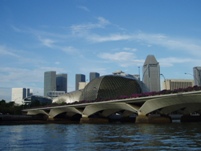Urbanization caused the pollution of Singapore River whose water became dark and unclean. In order to revitalize the river, strict measures were taken including pig farming prohibition in the area, and moving roadside food vendors, who had discharged wastewater, into buildings.
Singapore imports the half of its water from rapidly-growing Johor Bahru in the neighbor country Malaysia. The country has been eagerly working on: water development using domestic catchment; recycling sewage; and importing water from multiple sources.
>>More details (PDF 38KB)
By JRRN-secre | Category: Restoration Project,Other Asina Countries | Comment(0) | Trackback(0) |
Date: 2008.03.31 19:42
Most rivers in southwestern region (SWR) of Bangladesh depend on water flow from Ganges River. The flow volume declines during the dry-season and it impacts the region. Many of the branch rivers of Ganges River are blocked off from Ganges River due to the water intake at the upstream Indian Farakka Barrage that was built in 1975. Gorai River, a branch of Ganges River, is one of the major sources of freshwater supply to SWR and is the only one remaining branch river. However, in at least these twenty years, its flow volume in the dry-season (December – April) has been declining. It has a serious environmental impact: especially along the coastal areas around the sanctuary forests where the salty water has increasingly been intruding. In December 1996, the Bangladesh government decided to implement “Gorai River Restoration Project (GRRP)” to meet the urgent need of dredging Gorai River to restore the dry-season’s flow volume in SWR and the regional ecological balance. The research has been in progress through EGIS (Environment and GIS, Dhaka) for the problem of the Gorai River’s declining flow volume, and various alternatives and technological solutions have been studied (by the School of Geography, University of Leeds, UK). The Gorai River’s inflow point used to be closed in the dry-season, but thanks to the dredging with the PPW (Pilot Priority Work) Program, through the investments by the Dutch and Belgian governments, it has come to be kept in an open condition.
>>More details (PDF 35KB)
By JRRN-secre | Category: Restoration Project,Other Asina Countries | Comment(0) | Trackback(0) |
Date: 2008.03.31 19:18






